
Do you know the damage spam links can do to your SEO efforts? Spam links are amongst the greatest contributors to:
Scary, isn't it? How can you check your website's spam scores to remove them?
Understanding how to check website spam scores and deal with problems can sometimes be overwhelming. Various factors can affect your website's performance and ranking. One of the greatest threats is the use of spam backlinks. Having one spam backlink may mean little or no harm to your site, but having more than one on it can have life-threatening effects on its SEO strategy and rankings.
In this blog, we will provide a comprehensive guide on how to check website spam scores and discuss the meaning, functionality, and relevance of using metric scoring tools to ensure rankings.
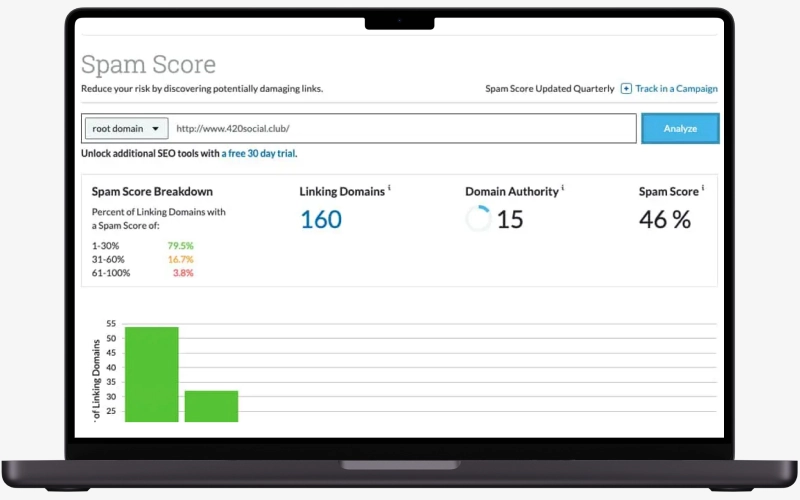
A spam score is a measurement that indicates the possibility of a particular site being penalized by search engines for indulging in so-called "spammy" operations. However, this does not suggest that a web portal is necessarily dubious. Several aspects influence your spam rating. This frequently shows a badly built and managed site. It also prohibits using black-hat SEO techniques to manipulate search engines, resulting in an increased overall rating.
Spam scores are important because they can provide you with two vital pieces of information about your current SEO efforts:
These two components are paramount when formulating webpages and generating back-links that will propel your ranking on search engines.
Additionally, it creates a foundation for assessing the degree of spamming of single pages and safeguards your website from being penalized.
Discover Your Spam Score and Learn How to Improve It Today!

Spam Score, Domain Authority (DA), and Page Authority (PA) are metrics used to ascertain website credibility and ranking prospects. Spam Score estimates how probable it is that some domains could be used for spamming, while DA and PA attempt to predict the search engine rankings of different sites. Combined, they give an all-encompassing view of any site's SEO performance and its possible.
Domain authority determines how a website ranks on search engine result pages and can determine its popularity. The scores may vary from 1 to 100, with the more authoritative high-scorers being better placed in search rankings. Developed by SEO firm Moz, domain authority considers more than 40 factors, including how old, big, frequented, and linked to other sites it is.
Remember that page authority is like domain authority but specific to some pages; it dramatically raises your website's rank and grows quicker than domain authority. To elevate page authority, you must narrow down particular pages and optimize them with relevant keywords; especially those competitors have not touched. Amazon provides the Alexa program, one of the best ways to look for keywords; it also gives new users a seven-day service.
Spam scores can be used to determine whether a website is trustworthy. The scores range from 0 to 17, with 0 being the most trusted and 17 being the least. So, sites with high scores might not be authentic because they are poorly designed or legit. Digital marketers use this metric to examine whether they can work with someone online.
In the internet world, almost every website has one or more indications of spamming. However, Google may perceive them as spam. The reason is that the Spam Score combines all the scores from a particular domain. This implies that if numerous spam reference points exist on an individual subdomain, the chances of being classified as a spam site by search engines like Google are much more significant.
Spam Scores solely indicate the likelihood of spam for subdomains. A subdomain is a third-order domain in the hierarchy of a website. Therefore, because this is what Spam Score concentrates on, no Spam Scores will exist for root domains and singular pages.
Please pay careful attention to that last sentence, as it's essential.
This implies two things:
What does this mean for you? It implies that you must research the subdomain and its pages before concluding whether or not it is spam.
More than a high spam score is required to ensure that a link is spammy. Other factors include several external links, top-level domain placements, and other scores. A site with a Spam Score of 8 does not mean it's automatically considered spamming. The same applies to a subdomain with a Spam score of 2; it does not guarantee that its backlinks are spam-free. Again, be careful to research both the site and page before determining if you should remove or disavow any backlink due to possible spam.
A tool for checking spam scores is of immense value as it shows how much spam your domain brings to your online space. Moreover, you can check multiple sites (up to 20) at once. Copy and paste or write your website address. When checking several sites, place every URL on a new line. The tool will analyze them and indicate their respective spam scores. You can find different tools that assist in checking web spam scores. The following are some of the well-known ones:
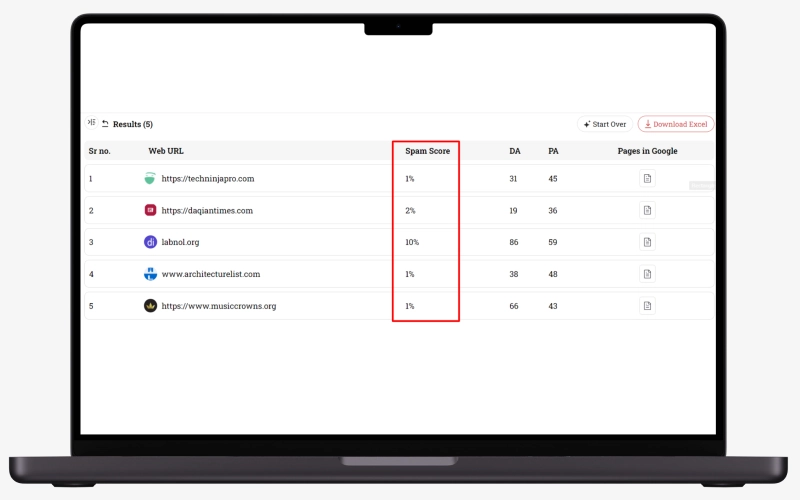
DA PA Checker tool helps establish a particular website's spam score. It is a flexible tool that instantaneously provides spam scores for no less than ten distinct sites. In addition to checking your domain Spam Score, DA PA Checker indicates Page Authority and Domain authority statistics. The tool will also show you how many website URLs are in the input box you have pasted them into. However, if the same website has been repeatedly pasted, the tool might remove duplicate URLs and domains to eliminate redundancy.
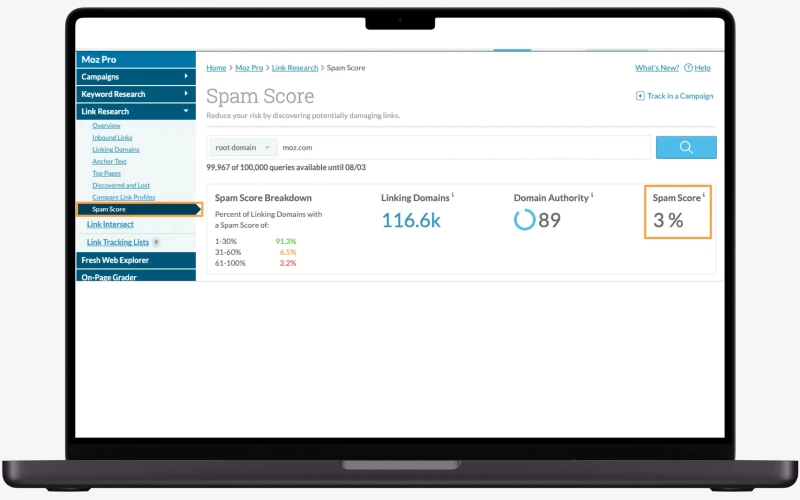
The Moz Spam Score Checker is a tool that helps you identify spammy links and page potential in your Google Analytics account. It compares your website with known spam on the Moz database to spot them. Any such links will appear at the top of the report in a table where you can see their URLs and anchor text. With Moz’s Link Explorer, for instance, you can see which pages from other sites are linked to competitors’ web pages on yours and vice versa. You may also assess its impact by looking at the Link Page Authority (or Page Authority) and Domain Authority (DA). The more powerful a link is, the higher its Page or Domain Authority value will be.
The spam analysis page currently contains a summary of pages or subdomains linked to your website. Therefore, one can analyze all URLs belonging to one subdomain in your site, a particular page, or even the whole root domain.
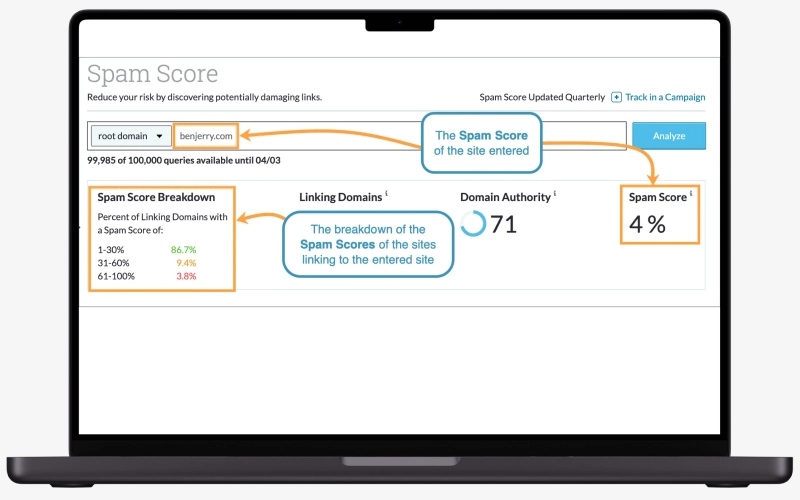
You can also see the Spam Score for other linking subdomains or pages nearby. Just below the original row of Spam Analysis Page, there is a feature which allows you to reject any file making it more suitable for measuring with Google Webmasters Tools. For example, let it be tailored to record any location with a certain spam marker checker or above that measure.
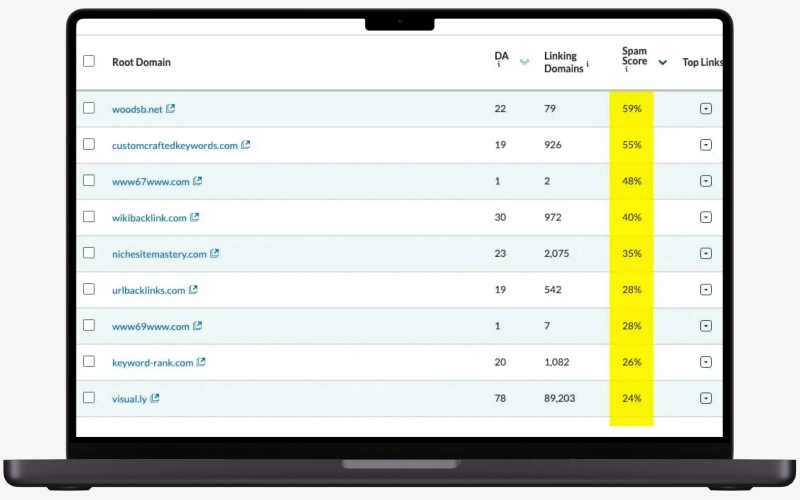
If your website has been affected by recent updates to Google’s webspam algorithm, you can use this tool to check. All you need to do is enter your website address and click on the “Check” button to see whether or not there are any changes you may have been influenced by from Google’s algorithm. This tool will automatically scan your site and inform you whether or not any such changes have influenced you. If, for example, it turns out that you are indeed a victim of these modifications, then the tool may suggest ways of fixing them on your site.
Spam, phishing, and other malicious email activities are defeated through three critical metrics: SPF (Sender Policy Framework), DKIM (DomainKeys Identified Mail), and DMARC (Domain-based Message Authentication, Reporting, and Conformance).
SPF enables email senders to determine the IP addresses authorized to send emails on their behalf and consequently helps avoid impersonation. DKIM is about verifying if an email came from where it says it did by offering some form of a digital signature proving its contents' authenticity. It also ensures no interference by anyone else at any stage while being transported over the Internet.
DMARC enhances SPF and DKIM by permitting domain proprietors to designate how mail bearers should manage emails that do not pass SPF or DKIM verifications.
SPF, DKIM, and DMARC are part of a three-pronged approach to deter attackers from misusing emails for their own purposes. The defense allows only legitimate senders to use a domain for email, and the content of any emails sent does not change between sender and receiver.
This may cause your web page to be flagged as spammy if it has heavy pages but scanty internal links. For search engines, a spamming website is such that it does not provide any valuable information in its content. These are some reasons why backlinks indicate that some web pages are worth being referred to by other pages or sites. If you just launched a new website for yourself, all your pages should be interlinked so that these individuals would get the message of how rich they are in terms of information.
If your website has way more dofollow links than nofollow ones, search engines can flag it as spam. A nofollow link is a hyperlink that directs search engines not to pass any link juice to the referenced page. This type of link includes an HTML tag saying “rel=nofollow” and won’t make any difference in the ranking of the respective page on SERPs. On the other hand, a do-follow link allows the passing of link juice to the page it is referencing. Hence, if a site has more do-follow than no-follow links, search engines might suspect it has purchased those unnatural do-follow hyperlinks.
A genuine website will always have contact information. Create a specific page for contacting us and include it in your header or footer menu. By showing that you have contact details, visitors visually classify you as a credible business entity to address issues when in need. See how JanBask does it:
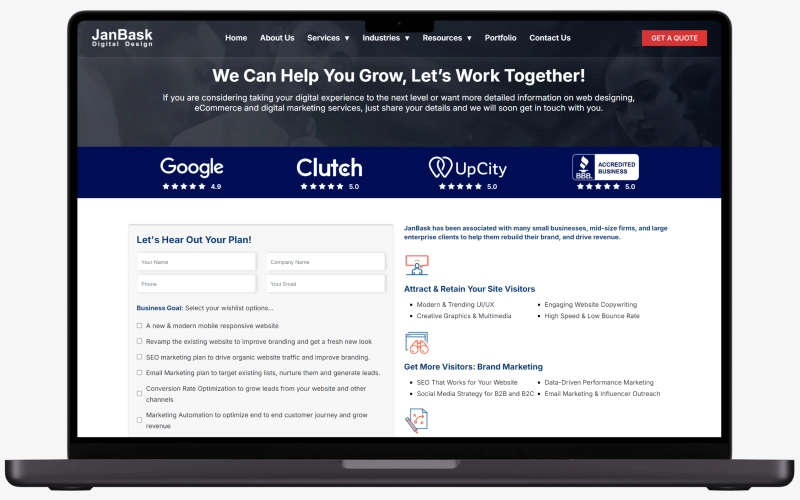
Websites should use high-quality content capable of answering users' search intent. At this level, search engines also want to deliver. In 2022, Google initiated its helpful content algorithm update to show searchers relevant and helpful information. The search engine giant also released E-E-A-T guidelines. Experience, expertise, authoritativeness, and trustworthiness are what E-E-A-T stands for. For people to trust you, your content must exhibit all these attributes for humans and machines. However, if you publish a lot of thin and low-quality content using AI tools, there is an excellent possibility that your spam score will increase.
To determine spam scores for a website, algorithms look at the content, structure, and other aspects to see how spammy it can be. Keyword usage, link patterns and site quality are sufficient ingredients in these algorithms. They also include tools like Moz, SEMrush, and Google’s algorithms, among other evaluators, which assign scores based on spam indicators. The score lets one know the chance of being penalized or flagged by search engines. Usually, this computation is through an automated process but might involve some manual reviews so as not to compromise accuracy.
Spam scores help users know and avoid search engine results, online directories, and low-class or perhaps dangerous websites. Very high spam scores show that a site may be participating in activities that contradict search engine policies, like keyword stuffing, link schemes, and other misleading tactics. By using spam scores in search engine marketing, lavishness is maintained. It also helps protect users against lousy material and wrong information.
A spam score on email measures the likelihood of an email being classified as spam by email filters. It is determined by analyzing the content, sender reputation, and other factors associated with the email. Higher spam scores suggest that the email contains elements commonly associated with spam, such as suspicious links or excessive use of specific keywords. Email providers use this score to filter out unwanted messages and prevent them from reaching the user’s inbox.
A spam score of 5 indicates a moderate risk of an email or website being flagged as spam. Some elements present could trigger spam filters but are not extreme enough to cause a high likelihood of being classified as spam. This score often reflects issues such as low-quality content or questionable link practices that may need addressing for websites. Reviewing the specific factors contributing to this score to take corrective actions is essential.
A website or email is usually never flagged as spam if it has a low score on the spam meter. The ideal spam score for a website is less than 1 or 2, indicating that the website follows the right processes and does not engage in spamming activities. The type of content here is usually good quality, written according to search engine guidelines, with a good link profile. Regularly auditing your content, enhancing your site quality, and avoiding any form of manipulation in SEO can help you maintain a healthy spam score.
If it is necessary to avoid an increase in your spam score, try to make your website's or email's content more valuable and relevant. This would mean avoiding any terms associated with spam, including copied material and deceitful actions. Furthermore, you must develop a standard and credible link portfolio that complies with the regulatory guidelines of search engine optimization and email marketing. It is also essential to assess your website for possible problems and adjust anything else that leads to the rise in its spam score. Moreover, this can be attained through cooperating with respectable organizations and adhering to their directives.
Digital marketers often emphasize the importance of domain authority in search engine optimization. However, factors such as page authority and spam score also play a crucial role and are closely tied to domain authority. While it is a helpful reference point, domain authority may only sometimes be completely accurate, as it can be manipulated. Many websites resort to copying content from various sources to inflate their scores.
Moreover, search engine algorithms are known only to Google, making it difficult to rely solely on domain authority for website performance. It's essential to focus on a comprehensive approach to improving search rankings, which includes monitoring domain authority and other relevant aspects. To truly enhance your search engine rankings, it's essential to consult a SEO Company to maintain authenticity in representing your organization and its offerings and to prioritize sound SEO practices rather than artificially inflating domain authority scores. One such safe step you can take is contacting JanBask Digital Design -your ultimate SEO confidant.
Interested in our Website Design Services?

Leave a Reply